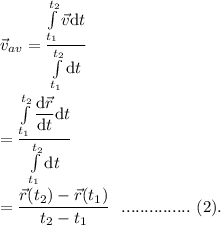
Physics, 16.09.2019 23:10 melissa578
Prove that the average velocity of a particle calculated for the time interval from t1 to t2 really is the average value of the particle’s instantaneous velocity v(t) over the same time interval. hint: you may not assume constant acceleration, so you will need to do an integral.

Answers: 1
Another question on Physics

Physics, 21.06.2019 17:20
American eels (anguilla rostrata) are freshwater fish with long, slender bodies that we can treat as uniform cylinders 1.0 m long and 10 cm in diameter. an eel compensates for its small jaw and teeth by holding onto prey with its mouth and then rapidly spinning its body around its long axis to tear off a piece of flesh. eels have been recorded to spin at up to 14 revolutions per second when feeding in this way. although this feeding method is costly in terms of energy, it allows the eel to feed on larger prey than it otherwise could. 1.a field researcher uses the slow-motion feature on her phones camera to shoot a video of an eel spinning at its maximum rate. the camera records at 120 frames per second. through what angle does the eel rotate from one frame to the next? 2. the eel is observed to spin at 14 spins per second clockwise, and 10 seconds later it is observed to spin at 8 spins per second counterclockwise. what is the magnitude of the eels average angular acceleration during this time? 3. the eel has a certain amount of rotational kinetic energy when spinning at 14 spins per second. if it swam in a straight line instead, about how fast would the eel have to swim to have the same amount of kinetic energy as when it is spinning? 4.a new species of eel is found to have the same mass but one-quarter the length and twice the diameter of the american eel. how does its moment of inertia for spinning around its long axis compare to that of the american eel?
Answers: 1

Physics, 22.06.2019 00:50
Acave rescue team lifts an injured spelunker directly upward and out of a sinkhole by means of a motor-driven cable. the lift is performed in three stages, each requiring a vertical distance of 10.0 m: (a) the initially stationary spelunker is accelerated to a speed of 4.90 m/s; (b) he is then lifted at the constant speed of 4.90 m/s; (c) finally he is decelerated to zero speed. how much work is done on the 68.0 kg rescue by the force lifting him during each stage?
Answers: 1

Physics, 22.06.2019 11:10
Rank the automobiles based on the magnitude of the force needed to stop them, from largest to smallest.2000 kg car going 5m/s500 kg car going 20 m/s1000 kg car going20m/s500 kg car going10m/s1000 kg car going10/s4000 kg car going 5m/s 0 0 603
Answers: 3

Physics, 22.06.2019 12:30
Urgent pls a. coal consumption levels off and remains flat. b. petroleum, natural gas, and renewables show an increase in consumption c. more nonrenewable resources continued to be consumed than renewable. d. there is little projected increase in nuclear energy use. e. carbon dioxide emissions are projected to decline as we approach 2040. global energy consumption is defined as the total energy used by an individual or organizations from around the world. use the graph above to analyze the projected energy consumption from now until 2040. which statements in the prompt apply? a) a, b, d b) b, c, d c) a, c, d d) a, b, c, d
Answers: 1
You know the right answer?
Prove that the average velocity of a particle calculated for the time interval from t1 to t2 really...
Questions


English, 11.02.2021 23:20



Mathematics, 11.02.2021 23:20


History, 11.02.2021 23:20




Chemistry, 11.02.2021 23:20









 .
. =
=  .
. =
=  .
.



 over the same time interval.
over the same time interval.

